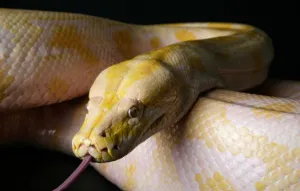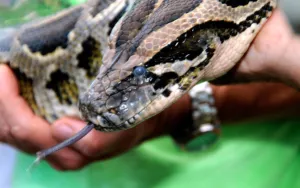
Table of Contents
Scientific Classification
- Kingdom: Animalia
- Phylum: Chordata
- Class: Reptilia
- Order: Squamata
- Suborder: Serpentes
- Family: Pythonidae
- Genus: Python
- Species: P. bivittatus
Quick Overview
The Burmese Python (Python bivittatus) is a large, non-venomous constrictor snake native to the dense jungles and grasslands of Southeast Asia. Recognized for its impressive size, striking coloration, and generally docile temperament, the Burmese Python has become a popular species in the pet trade.
Fast Facts
- Scientific Name: Python bivittatus
- Lifespan: Up to 20 years or more in captivity
- Average Length: 12 to 18 feet, with some individuals exceeding 20 feet
- Diet: Carnivorous, preying on mammals and birds
- Habitat: Jungles, grasslands, and marshes of Southeast Asia
Did you know?
Burmese Pythons are among the six largest snake species in the world and are notorious for their ability to consume prey as large as deer and pigs.
Appearance
These pythons exhibit a distinctive pattern of light and dark markings, with a background color that can vary from shades of brown to yellow. Their sleek bodies, heat-sensing pits, and muscular build contribute to their efficiency as ambush predators.
Size and Weight
Adult Burmese Pythons commonly reach lengths of 12 to 18 feet, with exceptional individuals surpassing 20 feet. They can weigh anywhere from 100 to 200 pounds or more, depending on factors such as age and feeding habits.
Temperament and Behavior
Known for their generally calm demeanor, Burmese Pythons are often considered docile, especially when raised in captivity from a young age. However, their large size demands careful handling, and they may become more defensive if they feel threatened.
Habitat and Distribution
Indigenous to Southeast Asia, Burmese Pythons are found in a range of habitats, including jungles, grasslands, and marshes. They are particularly associated with the countries of Burma, Thailand, Vietnam, and Indonesia.
Care Guide
While Burmese Pythons are popular pets, their extensive size and specific care requirements, including a secure enclosure with proper heating and humidity, make them suitable only for experienced reptile keepers.

Diet and Nutrition
In the wild, Burmese Pythons feed on mammals and birds. In captivity, they are commonly offered a diet of appropriately sized rodents. Feeding should be carefully regulated to avoid obesity.
Fun Fact
Burmese Pythons are ambush predators, relying on their excellent camouflage and patience to lie in wait for prey to approach.
Health and Wellness
Regular veterinary check-ups are crucial for captive Burmese Pythons. Health concerns may include respiratory infections, obesity-related issues, and complications associated with their rapid growth rate.
Reproduction
Burmese Pythons are oviparous, laying clutches of eggs. The incubation period lasts approximately two to three months, and hatchlings are independent upon emerging.
Conservation Status
In their native range, Burmese Pythons are not considered endangered. However, invasive populations in Florida, USA, have raised ecological concerns, prompting management efforts to control their impact on local wildlife.
Fun Fact
Burmese Pythons are adept at climbing, utilizing their strong muscles and body structure to ascend trees and explore elevated spaces.
Photo Gallery




Related Profiles
Share This Profile
3 Fascinating Facts About Burmese Python
- Impressive Size: Burmese Pythons rank among the largest snake species globally, with documented cases of individuals exceeding 20 feet in length.
- Versatile swimmers: These pythons are comfortable in aquatic environments, and their ability to swim long distances contributes to their adaptability.
- Invasive Impact: In the Florida Everglades, Burmese Pythons have established an invasive population, impacting native wildlife and raising conservation concerns.
- Enchi Ball Python: A Unique and Stunning Morph of Python regius - March 27, 2025
- Emerald Tree Monitor: The Enigmatic Green Guardian of the Rainforest - March 26, 2025
- The Egyptian Cobra (Naja haje): A Fascinating Serpent - March 25, 2025
